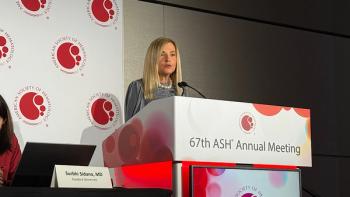
Health as More Than Illness: Impact of Social Determinants and Trauma
Treating illnesses is important, but it would be a mistake to think that is the full extent of health. Panelists during the National Alliance of Healthcare Purchaser Coalitions’ 2019 Leadership Summits, held June 24-26 in Pittsburgh, Pennsylvania, discussed the impact of social determinants and past trauma on health and how employers can ensure they are addressing these issues to improve health and outcomes.
For the third year in a row,1 data has shown that life expectancy in the United States is on the decline, and part of the decline has been due to preventable causes and social determinants of health. The falling life expectancy underscores what the World Health Organization (WHO) knew when it wrote in the preamble to its constitution that “Health is a state of complete physical, mental and social well-being and not merely the absence of disease or infirmity.”
Treating illnesses is important, but it would be a mistake to think that is the full extent of health, explained Jeremy Nobel, MD, MPH, founder, the UnLonely Project. There are other components, as noted by the WHO, and socioeconomic drivers, like education, income, community health, and social connection, and health behaviors, such as tobacco use, account for 70% of what makes up “health.”
While Angus Deaton won the Nobel prize in 2015 for showing that social welfare and economic growth are tied together, the data also showed that there is a connection between social welfare and health.
“These social determinants of health are lethal,” Nobel said. “They’re not just having a bad day—they will kill you.”
Why should employers care? These social determinants are affecting quality of life, as well as engagement not only in self-care, but also with colleagues and customers.
The social determinant that employers can do the most about is family and social support. Loneliness, he said, resonates at the employer level, but they just don’t call it that. They call it connection or belonging. Nobel’s organization has worked over the past year on loneliness with the City of New York, Goldman Sachs, and Prudential Financial. The UnLonely Project added 3 questions to Prudential’s annual health survey and found correlations with mental health and chronic conditions. The project also found through its work with Prudential that lonely people are more expensive to insure and had lower performance at work.
“I would suggest that we consider social determinants of health as much more than minor mental health issues and stress,” Nobel said. More typically, social determinants are held off in favor of dealing with “bigger” issues like diabetes, heart disease, and low back pain.
Connecting with people on a personal level can help highlight the social determinants of health at play or other factors that impact a person’s health. Diana Bishop, MA, senior learning consultant, Kaiser Permanente San Diego (KPSD), outlined the Adverse Childhood Experiences (ACEs) and how they interact with health. The ACEs study came about in the early 1990s after Vincent J. Felitti, MD, of KPSD, saw half of his participants in an obesity study drop out despite losing weight. After speaking with the patients, he realized the majority of them had experienced childhood sexual abuse.
One patient told him that once she started losing weight, she started getting compliments and attention at work that she wasn’t comfortable with as a survivor of childhood sexual abuse, so she started eating more. “Overweight is overlooked, and overlooked is what I need to be,” Bishop recounted the woman telling Felitti.
ACEs look at 10 factors of trauma in 3 categories: abuse, neglect, and household dysfunction. The higher the ACE score (out of 10), the greater a person’s risk of certain health issues, Bishop explained. An ACE score of 4 or higher puts a person at a 3 times greater risk of lung disease and smoking, a 2 times greater risk of liver disease, a 4 times greater risk of developing depression, and at 14 times greater risk of suicide attempt. People with an ACE score of 6 or higher are likely to die 20 years earlier than people with an ACE score of zero.
“This isn’t ‘those’ people. This is ‘us.’ These are our friends, our family,” Bishop said. “In every community in the United States. So, people don’t think that it’s just a certain ethnicity or certain socioeconomic class. This is across the board.”
The trauma these individuals face early on in life is interwoven with their social determinants of health and how they cope with what happens to them. Food becomes more than just sustenance—it becomes a way to cope or protect oneself. As a result, these people are facing chronic diseases.
“People are trying to cope, but in their coping, those poor health habits become lifelong problems,” she said.
A high ACE score is not a death sentence, though, Bishop stressed. There are ways to help these individuals and the best way is through positive relationships and mentoring. She advocates for having discussions around these issues rather than hiding these issues.
Finally, Jaclyn Wainwright, chief executive officer, AiRCare, noted that too much focus on health outcomes and chronic diseases can make the system lose sight of the person.
“If we continue to have health-oriented problem conversations with our employees, we’ll look at our employees and see really sad, sick, unconnected individuals,” she said.
Context is important and can be understood by asking what matters to the individual, but it’s often not a conversation that happens in the workplace. AiRCare is trying to solve for what is missing from communities: compassion, empathy, and connectedness.
Wainwright outlined how trauma and social determinants impact health through the example of someone her company helped. The 47-year-old construction foreman had back pain that was affecting his work. He went to the doctor, who prescribed opiates and also put him on medication for his high blood pressure.
After AiRCare reached out to him and put him in touch with a physician, his back pain was diagnosed as a mental issue resulting from the trauma of his wife leaving him. The back pain was an emotional trauma and not a physical pain. He was recommended to start meditating and taking more time for himself, and after a few months, the back pain was going away, and he was off his blood pressure drugs.
“When we’re just looking at the symptom and not the root cause, we aren’t treating the problem at all,” Wainwright explained.
Reference
1. Dyer O. US life expectancy falls for third year in a row. BMJ. 2018;363:k5118. doi: 10.1136/bmj.k5118.
Newsletter
Stay ahead of policy, cost, and value—subscribe to AJMC for expert insights at the intersection of clinical care and health economics.









































